Sahiyo and Khatna survivors get attacked online through ‘organized trolling’

In the recent years Sahiyo has come across many dissenting views while engaging with followers on the internet on the topic of ending Female Genital Cutting. The dissenting views have come in the form of tweets, comments, emails, people personally dissuading us from our work, and more. And every time someone has tried to tell us that Female Genital Cutting is beneficial for the woman, we have tried to present a reasoned argument against it. It is our mission to create a counter-narrative on Female Genital Cutting in the communities practicing it, through dialogue and education. That said, we recently observed a phenomenon of ‘organized trolling’, a spate of attacks online. A few days ago, Sahiyo’s Facebook page was attacked with negative reviews from different people. It happened in a quick span of a few minutes and oddly enough every review had almost the same things to say. The trolls gave Sahiyo one-star ratings and called us a ‘sham organization’. In some reviews, co-founders were named individually and discredited for bringing shame to the community. Furthermore, these reviews stated that Sahiyo co-founders are creating a fake narrative against Female Genital Cutting prevalent in the community for their personal gains. This kind of behaviour qualifies as online harassment, because it is an intentional attempt to attack and discredit a group and its individual members in manner that is not civil. In 2015, Sahiyo conducted an anonymous survey with 385 respondents out of which 81% people responded that they didn’t want the practice to continue. Since its inception, the number of people supporting Sahiyo’s mission has increased manifold, as men and women from the community have come out against the practice. Yet there is a significant number of people who fear openly coming out with their views against the practice. Online harassment through organised trolling is one among the many reason why people fear voicing their opinions publicly. Through Sahiyo, we want to create a safe space where opinions on the practice could be heard and tolerated, not trolled and shunned. By attacking online and publicly shaming, the pro-khatna supporters have displayed their intolerance against any view that counters or challenges the practice. FGC is illegal in many parts of the world including United States and Australia, where people from the Bohra community have faced legal action for practising Female Genital Cutting. Furthermore, the jamaats (congregations) in US, UK and Australia came up with notices asking members not to practice FGC because it is against the law of land. Yet pro-khatna supporters continue to defend the practice, and in doing so, some of them resort to trolling or online harassment through foul language and personal attacks of those why they disagree with. While claiming that they have personally not had negative experiences with FGC, they attack, discredit and dismiss the personal experiences of others who have had negative experiences with FGC and have taken the courage to share their stories. While we disagree with pro-khatna rhetoric which has been passed down since generations within the community, we — and the FGC survivors who share their stories with us — want to create room to have a dialogue and debate around it without being personally attacked. Many women who have undergone FGC already have a challenging time talking about their experience openly. There is a fear and shame associated with sharing their stories — shame that it happened to them and perhaps feelings of not wanting to be viewed as victims. There is also a very real fear of backlash and of not being believed, and online trolling validates these fears. Trolling makes it more difficult and dangerous for people to come forward, and for community members to feel supported because of something they feel. Furthermore, it is only a clear exhibition of intolerance prevalent in the community, which quells voices of the people who don’t agree with their mandate. Sahiyo strongly condemns online trolling of those who have voiced their views against the practice. Online harassment or trolling leaves no room for debate or dialogue.
Penn State Law School Host Conference on Female Genital Cutting
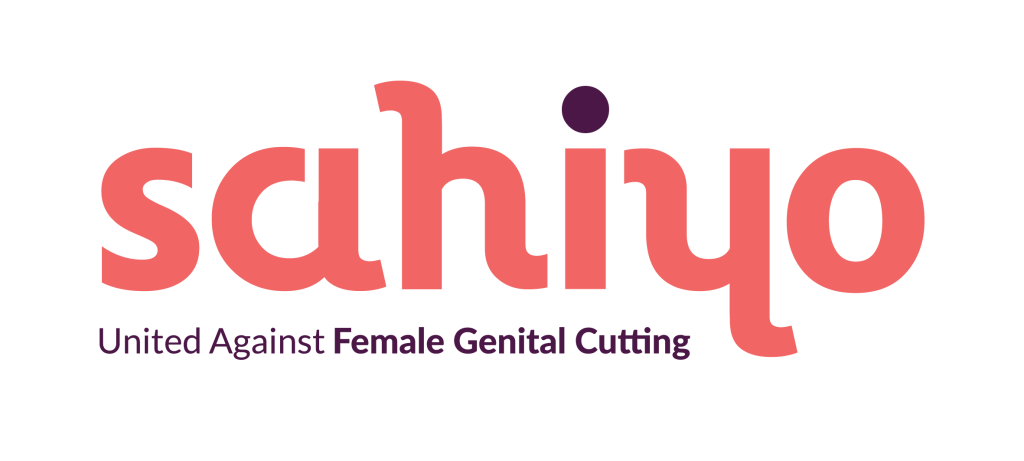
On April 12-13th, the Dickinson Law’s FGM Legislation Project hosted a conference, “Crafting Legislative and Medical Solutions to Address Female Genital Mutilation Locally and Internationally,” at Dickinson Law. This conference aimed to educate the public, lawyers and medical professionals about the legal, social, psychological and medical consequences of FGC. Experts and practitioners gathered to address the medical implications for women who have undergone it, the need for legislative action, and cultural competencies and prevention. Sahiyo Cofounder, Mariya Taher participated in a panel session, “Effective FGM Prevention and Survivor Advocacy.” A live stream of the event can be found here. On April 13th, a working group gathered to create and discuss an optional protocol to the Convention on the elimination of all forms of discrimination against women that focuses primarily on Female Genital Cutting.
I Said It Loudly: I am an FGM Survivor. Meeting FGM Survivors for the First Time Was My Cursed Blessing
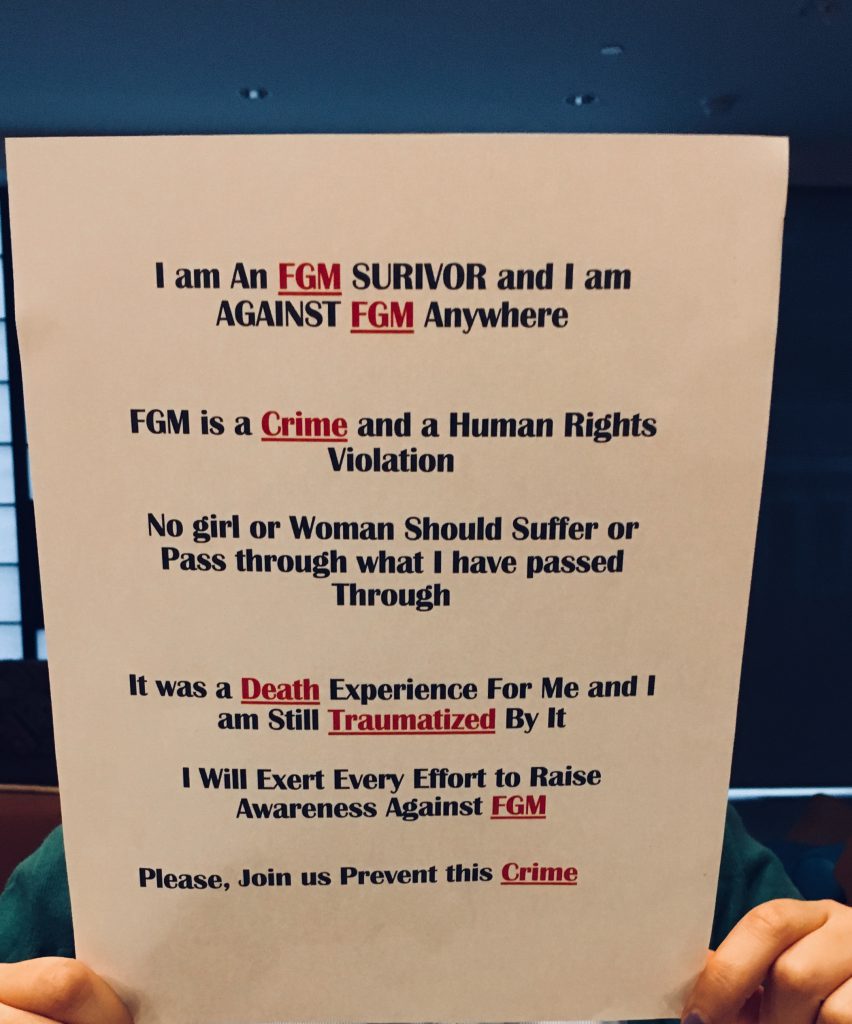
(Note: The following blog was written by a survivor who attended a meeting, the topic of which was on mental health and FGC. Her story highlights the power of storytelling and how it helps break the isolation that many survivors experience in having undergone FGC and dealing with their trauma afterwards, an isolation that Sahiyo is attempting to break via the storytelling work we engage in with communities.) By Anonymous Country: Egypt & United States Even now, despite my brain trying to convince me it was a good idea to attend a conference on FGM and Mental Health, I cannot emotionally explain what really happened that day. The conference consisted of FGM survivors, human rights advocates, therapists, and policymakers, and almost two weeks after having attended, I started to have stronger flashbacks of the terrible experience I underwent with FGM in my home country, Egypt. I have mixed feelings of love, support, and pain for having attended that conference. My journey dealing with that horrible experience started in my home country where my rights as a human being were violated without my consent. I was bleeding and almost died having been operated upon twice. Even now, I cannot easily write these words. You may wish to read my full story published here. The experience of meeting with other survivors from India and other countries was something I strongly needed to help bring me face to face with the many answers to the many questions in my mind regarding why I experienced so much anxiety, sadness, depression, panic, and fear after my cutting. I wanted to know how other survivors had dealt with their FGM especially those who spoke up about it publicly, such as (Mariya Taher, Leyla Hussien, Jaha Dukureh , Naima Abdulhadi, and others) ; I am relatively new to openly talking about it and I still feel as if I am climbing a mountain when trying to share or speak about it. I heard these women saying how it was and is still difficult; and listening to them has helped me to feel that I am not alone in my experience. I saw how powerful the pain of this experience can be, but at the same time was inspired by the courage of what they and I were determined to do. To speak up about FGM openly and to try to prevent it from happening to other girls. That meeting was the first time I met with and spoke to other survivors from different countries, such as the United Kingdom, Gambia, India, not to mention the United States. At the time, I felt happy that this meeting could serve as a comfort zone for me, knowing others understood what I had gone through. Seeing all those women in that room encouraged me to say amongst the group of almost forty members that I too am a FGM SURVIVOR. I knew these women would not shame me and I did not need to fear being labeled, judged, or threatened for publicly admitting I was a survivor. My heart was beating and my breath was short as if I had climbed a mountain. I thought I was ok during the 8-hour meeting, yet I collapsed and burst into tears at the end; I cannot precisely tell you why, but I thought about how it is unfair that our bodies and souls are violated with this harmful crime. Most of the time I feel sad that I had to go through these painful thoughts, feelings, or flashback of the operation room and after. It feels like I am being retraumatized when something happens to trigger the original trauma of FGM. I beg every mom and dad to see their daughters as beautiful souls who do not need to be cut to be pure. I am Muslim, and I can say it strongly, clearly, and angrily: Do not make it religious because it is not. My body was not supposed to be violated in this severe way nor was my soul. Yet, both happened. But I am comforted in knowing that there are others who I can talk to who understand my pain. FGM is a crime and more work needs to be done with healthcare professionals, as well as policy makers. Girls must be protected from being cut and survivors should be supported with the needed assistance to help them heal.
Sahiyo in the U.S. presents a workshop opportunity in May 2018 in collaboration with StoryCenter
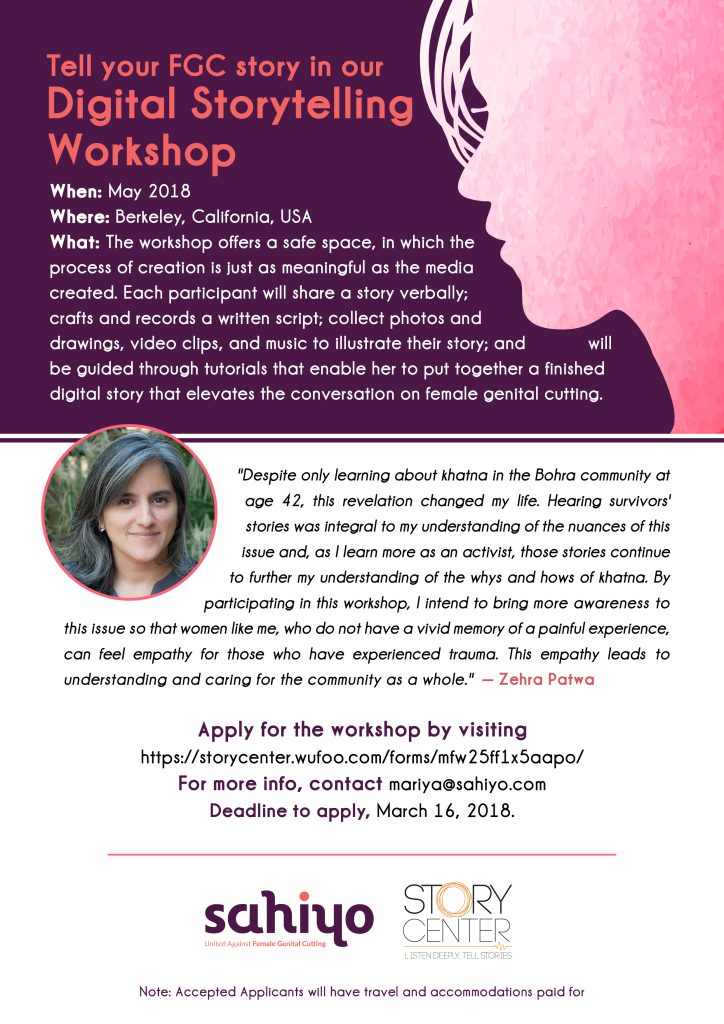
From May 4-6, 2018, in conjunction with StoryCenter, Sahiyo in the U.S. will host a 3-day workshop in Berkeley, CA where eight women who grew up in the Bohra community and live in the United States can come together to create their own digital storytelling videos about FGC and the work they do. This project will culminate in the professional production of a two- to three-minute video of participants sharing the story of their anti-FGC advocacy journey. Participants will have full access to this video and full permissions to use it for their own ongoing community leadership and advocacy efforts after the training, and the facilitators will also work to deepen your knowledge of participatory storytelling and the various uses and applications of digital storytelling. If you’re interested in applying to participate in this advanced training—StoryCenter Sahiyo & in the U.S. will cover the cost of the project itself, as well as transportation and accommodations—please read the info below and complete this application by Friday, March 30, 2018. If you have any questions about this project, please feel free to contact mariya@sahiyo.com To see past examples of videos produced by our partner, StoryCenter, click here. To see Mariya’s StoryCenter video, click here.
Sahiyo Activist Needs Assessment: Learning How To Support FGC Activists
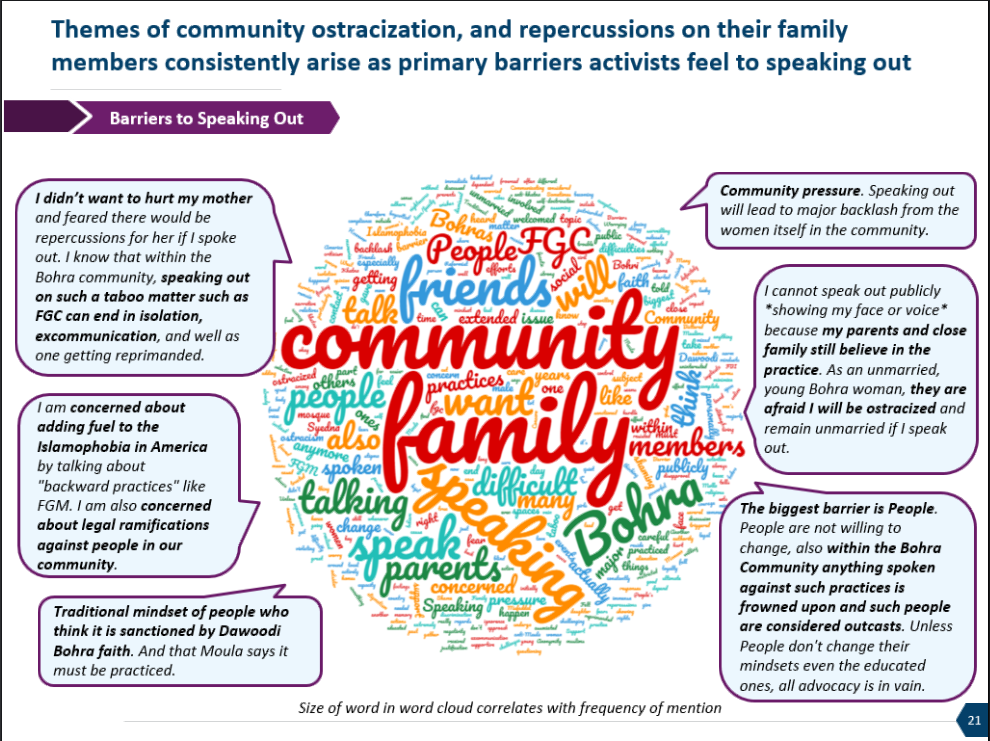
Research Summary & Implications Background Sahiyo is dedicated to ending Female Genital Cutting (FGC) in the Bohra community, a small global Shia Muslim community. Sahiyo focuses its efforts on public education about the prevalence and impact of FGC, community outreach initiatives, and supporting survivors and activists, with the ultimate goal of driving positive social change around gender violence. Sahiyo recently partnered with a healthcare market research consultancy to conduct primary market research with activists speaking out against FGC, in an effort to better understand activists’ challenges and hopes for the future. In this article, we hope not only to summarize the key findings from our primary research and draw implications for the broader gender violence activist community, but also to underscore the importance of conducting primary research with activists. Research Methodology Research entailed two phases: first, a quantitative, online survey was sent to anti-FGC activists across the globe. Second, follow-up interviews were conducted with activists from the online survey sample, who expressed their willingness to further participate in the research. Sample & Demographics All activists who took part in this research grew up in the Dawoodi Bohra religious tradition, and are now self-described as active in speaking out against FGC (‘khatna’). Phase 1 Quantitative Sample: Between 40-50* activists took the online survey, 91% of whom were female. Activists’ ages varied, though 56% were under the age of 35. The majority (~3/4) of activists reside in either the United States or India and were highly educated, with 96% having at least some graduate degree. Although respondents were raised Dawoodi Bohra, only 43% still identify as Dawoodi Bohra, while 37% are non-practicing. However, 67% of respondents socialize with Dawoodi Bohras at least sometimes (every couple of weeks). 69% of respondents personally underwent FGC, while 94% had a mother who was cut. Phase 2 Qualitative Sample: 7 activists were interviewed in follow-up telephone conversations. These 7 activists had variable ages, countries of residence, and genders. Key Findings Although each activist’s story is unique, they all shared the drive to end FGC in their community and more broadly. Their activist journey typically started with a realization about the prevalence of the practice: whether this be through a family member speaking out, a documentary, or media coverage; the realization sparked further investigation. Although some activists had memories of their own experience of being cut, many did not. For the latter individuals, the realization as adults about the practice’s prevalence occasionally came with a realization that they too had been cut, triggering an intense emotional response. For all activists, the initial anger and shame upon learning of the practice’s prevalence often led them to ask family and friends about FGC in their community, but they were met with a culture of secrecy and silence. Even when activists did open conversations with family and friends, they found the practice was often justified as a longstanding tradition, necessitated by religion. This culture of secrecy and acceptance, paired with painful body or narrative memories of their own cutting, were said to be key drivers to speaking out. Many activists feel that not only does FGC have long-term physical and psychological health impacts, but that it is also a form of child sexual assault and/or abuse given the lack of consent. Furthermore, activists acknowledge that FGC’s underlying misogynistic and patriarchal factors make it part of a larger movement to control women. In short, activists feel that FGC does only harm with no benefit and must therefore be ended. Challenges to speaking out: Overlap of religion and community The most significant challenges activists face when speaking out stems from the high degree of overlap between religion and community in the Bohra community. Although most activists are fairly open with their families and friends about their activism, they feel only moderately supported by their loved ones, largely due to concerns with the activism’s social repercussions. These concerns are linked to the social characteristics of the Bohra community, which include long-standing traditions of loyalty and closeness, in which the religious community often dictates social circles, romantic partners, neighborhood housing, cemetery sites, and more. This overlap causes speaking out against FGC to be seen as an attack on the community and faith at large. As a result, activists fear that speaking out would lead to discontinued social and professional bonds and ceasing of access to religious privileges. For some, these potential social repercussions bar them from speaking out publicly, so they pursue more private means of activism, such as anonymous writing and supporting organizations like Sahiyo. Religious authority Concerns with speaking out are further driven by the authority of the Bohra religious leaders. Considering that there is no clear religious justification for FGC, its continuation relies upon the leaders’ mandates and interpretations. Questioning of the religious leaders is deeply discouraged and potentially dangerous—causing many activists to not only fear speaking out, but also sometimes demotivating them, making them feel that without the support of religious leaders, their activism is a ‘lost cause.’ Considering the challenges above, many activists feel torn between wanting to end the practice and wanting to maintain a close connection to their faith and/or community. Even activists who are no longer involved in the Bohra community still fear risking the social wellbeing of their loved ones. Activists present this as a ‘catch-22’: loyal Bohra members are well respected by their community; however, speaking out against a taboo practice might oust them from it, rendering their authority no longer valid. Conversation challenges When activists do speak out publicly or privately, they find the conversation about FGC particularly challenging. The lack of robust, publicly available information about the practice’s prevalence in the Bohra community, as well as about its physical and mental consequences on the girls’ health often result in other Bohra members undermining the impact of khatna. Many community members present khatna as ‘not as bad as other types of FGC’. These arguments are particularly difficult for activists who do not have a clear memory of their own experience
Sahiyo to be a part of a new global movement for progressive Muslims

Why doctors need to speak out against female genital cutting in India
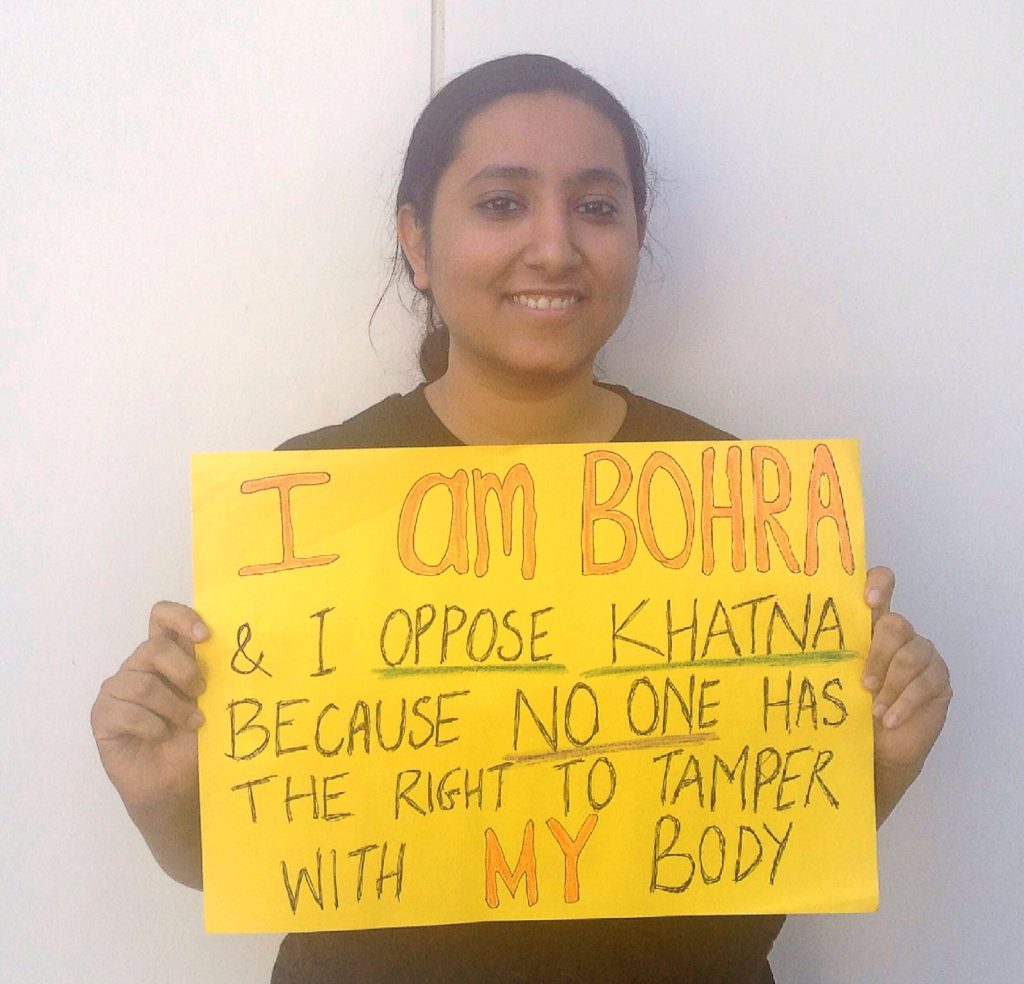
By Aarefa Johari (A shorter version of this piece was published on the British Medical Journal’s blogs site on January 20, 2017. Read it here.) Two years ago I met Sara (name changed), a bright mother of two and a member of the Dawoodi Bohra community in Mumbai. From the time her daughter was a baby, Sara was determined she would not put her child through the ritual of khatna – female circumcision – that is considered mandatory for all Bohra girls. She had heard too many times that khatna is done to curb a girl’s sexual urges, and she was completely against the practice. But when her daughter turned six, family pressure began to mount. Her mother-in-law was adamant that the child had to be cut at the age of seven, and after months of trying to resist, Sara finally caved in. She saw no choice but to have her daughter circumcised, so she decided to do everything in her power to ensure that khatna didn’t leave her little girl traumatised. No traditional, untrained “cutters” who use razor blades or knives to slice the clitoris; she wouldn’t even take her daughter to just any Bohra doctor authorised to perform khatna. Instead, Sara sought out a gynaecologist who agreed to completely sedate the child during the procedure. Female circumcision, known around the world as Female Genital Mutilation/Cutting (FGM or FGC), is recognised as a human rights violation by the World Health Organisation. It involves cutting or altering parts of the female genitalia for non-medical reasons. There are various types of FGC practiced around the world, with varying degrees of severity. The kind that Bohras practice – cutting all or part of the clitoral hood – falls within WHO’s definition of Type 1 FGC. The practice is illegal in at least 40 countries, because there are no medical benefits to cutting any part of the female genitalia. In fact, even the mildest form of FGC can have harmful health consequences, including bleeding, swelling, painful urination, infection and reduced sexual sensitivity. And yet, just two years ago, Sara’s seven-year-old daughter was cut in an operation theatre in a Mumbai hospital, by a licensed gynaecologist who administered general anaesthesia on the child so that she would have no memory of her clitoral hood being removed without consent. If most doctors and medical associations in India are unaware of such incidents, I wouldn’t be surprised. Until a few years ago, almost no one had heard of Female Genital Cutting being practiced in India. Even international campaigns against FGM/C focused mainly on Africa, and only in the last few years has it been acknowledged that FGC is globally prevalent. But in India, Bohras have been secretly circumcising their daughters for centuries. Like so many seven-year-old Bohra girls, I was cut as a child too. We are not a large community – barely two million in number – but those familiar with Dawoodi Bohras know us as a close-knit, well-educated, wealthy business community with a reputation for being progressive towards women. But the Bohras are the only group known to practice FGC in India so far. Other Indian Muslim sects don’t even consider the ritual Islamic, because there is no mention of it in the Quran. Bohra families, depending on who you speak to, give a variety of different reasons for practicing female khatna. “It is in the religion”, “it curbs sexual desire” and “it prevents pre-marital and extra-marital affairs” are the most common justifications; other reasons include hygiene and health, specifically the prevention of urinary tract infections and other diseases. Medically, of course, there is no proof of such claims. More recently, some Bohras have begun rationalising khatna with the strangest argument: they claim it is the same as “clitoral unhooding”, a surgical procedure that a number of doctors in Western countries perform on adult women to enhance sexual pleasure. I first heard this argument from Sara, a few months after her daughter was cut. The child may have been sedated in the OT, but the mother was still deeply uncomfortable with her khatna. After the “surgery”, Sara spent hours online trying to understand what exactly had been cut and why. She then came across a website on clitoral unhooding. It claimed that by removing the hood covering the clitoral glans, the clitoris is more exposed and thus experiences more stimulation and pleasure. Sara shared the website with another Bohra doctor who performs khatna. “Yes, this is exactly what our khatna is. It is done to enhance sexual pleasure,” the doctor claimed. This affirmation came as solace for Sara – her daughter was not harmed after all, and khatna turned out to have a “positive” intention. Her maternal relief was blind to the gaping holes in this “clitoral unhooding” theory, which were obvious on the website itself. As a surgical procedure, unhooding is recommended only for some sexually active women, if they have excess prepuce tissue that hinders orgasms by preventing the clitoral glans from protruding during arousal. Otherwise, the hood serves important function of protecting the clitoris from over-stimulation or abrasions. Unfortunately, now that there is a growing movement against FGC within the community, many khatna supporters are trying to promote clitoral unhooding as a “scientific” justification for cutting all seven-year-old girls without consent. If this isn’t enough to mislead parents, we are also witnessing another disturbing trend: the medicalisation of khatna. Medicalisation refers to the trend in which the cultural, non-medical practice of FGC is increasingly performed by a trained medical practitioner instead of an untrained traditional cutter. For several years now, Bohras in bigger cities like Mumbai have been getting their daughters cut by doctors (though not necessarily gynaecologists) in Bohra hospitals or clinics. They have come to realise that untrained cutters are not only unhygienic, but are also more likely to cut more than intended – particularly if the child is kicking or resisting the cut. The trend is now also spreading to smaller cities and towns. A few months ago,
To those who say that Sahiyo is not their voice…

By: Anonymous Country: United Kingdom The past few days have been an emotional rollercoaster for me. I deeply believe in the values that Sahiyo espouses and wholeheartedly wish for the practice of FGC to end. To my dismay, I have witnessed a hate campaign against not only Sahiyo but the brave people who have been vocal against this practice. To those who say that Sahiyo is not their voice, I would like to clarify what Sahiyo is. Sahiyo is a cacophony of voices, a roar from a collective of activists whose voices unite. We are individuals who speak for ourselves and on behalf of minors, who have tried and continue to try to engage in dialogue to end this practice. In return, we have received silence and now slander. Our character, faith, morals, and intentions have been questioned and attacked. I, along with the community of activists who share my sentiments, do not speak on behalf of Sahiyo, or indeed any other adult. I speak on behalf of young girls who are forever altered without their consent; I speak on behalf of the innocent young girls across the world who have undergone this procedure or who will do so in the future; I speak on behalf of the girls who do not have a voice and are not old enough to understand what is happening to them and I speak on behalf of my 7-year-old self, who did not choose to undergo a procedure that has affected me for decades and will continue to do so. Now that I have a voice, I am being attacked for using it. I gain nothing from speaking up. No amount of campaigning will ever undo the permanent emotional, psychological and physical damage that resulted from a procedure that was deceptively forced upon me. To those who slander me, this is what I have to say to you: You are right to an extent – I do speak on behalf of others. I speak on behalf of your daughters, sisters, cousins, children’s friends, and every young girl who will undergo this invasive procedure so that they don’t suffer the way that I have. I hope that you remember this the next time you say laanat on me.
U.S. Muslim Leaders Stance on FGM/C (also known as Female Circumcision)
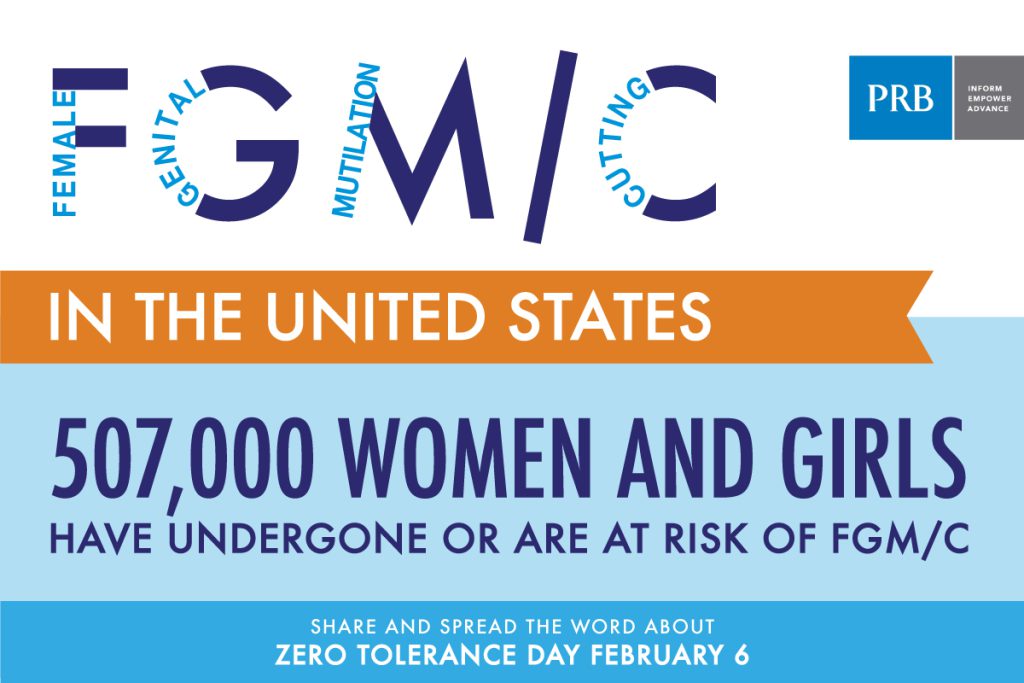
(Originally document can be found here. Republished with permission on 6/7/2017) We, Muslim organizations, FGM/C Survivors, Islamic scholars, and leaders, strongly condemn the remarks made in the video of Imam Shaker El Sayed where he clearly distinguishes between Female Genital Mutilation or Cutting (FGM/C) and female circumcision, and recommends the performance of female circumcision on young girls “when needed” to prevent them from becoming “hyper-sexual”. We commend Dar Al Hijrah on their response to these remarks condemning FGM/C. To further clarify, FGM/C is the same as female circumcision. When we refer to FGM/C, we are including female circumcision which falls within the definition of this practice. More than half a million women and girls living in the U.S are at risk of undergoing FGM/C both in the U.S. or abroad or have already undergone the procedure, including 169,000 girls under the age of 18, creating a clear urgency for action. The following presents our stance on the issue of FGM/C: FGM/C includes all forms of excision of the female genitalia. FGM/C is known as female circumcision, but they are the same practice. There is no reference to FGM/C in the Holy Quran and the practice is agains t Islam ic doctrine. According to the World Health Organization guidance from 2016, FGM/C has no health benefits and serves no medical purpose. All forms of FGM/C can cause lifelong physical, psychological and spiritual harm to the young girls forced to endure this. Because FGM/C causes harm, it is prohibited under Islam. Examples include: Physical harm: This includes health complications such as severe pain: excessive bleeding: general infections; urinary tract infections; wound healing problems; injury to surrounding genital tissue; menstrual problems (painful menstruations, difficulty in passing menstrual blood, etc.); sexual problems (pain during intercourse, decreased satisfaction, etc.); increased risk of childbirth complications; the recurring need for additional surgeries; and death Psychological harm : This includes mental illness diagnoses of depression, anxiety, and/or post-traumatic stress disorder/ low self-esteem Spiritual harm: This includes tension on one’s spiritual relationship with God and with one self; detachment from the spiritually-ordained sexual self; strain of physical and mental harm on one’s spiritual connection; feeling ostracized from one’s community as a result of feeling unworthy and ashamed Islam is a religion rooted in social justice. Arguing that FGM/C is recommended to curb the sexuality or so-called “hyper-sexuality” in females is wrong. Islam supports the sexual health of both males and females, and controlling female sexuality is a form of patriarchy, not Islam. We would like to reiterate that all forms of FGM/C are against the law in the United States. Federal Law makes it illegal to perform FGM/C in all its forms, including female circumcision on girls in the U.S or to transport a girl out of the U.S to have FGM/C performed in another country. In addition, 25 states in the U.S, including the state of Virginia, also have laws against FGM/C. We would like to make clear that FGM/C is a universally recognized human rights abuse. It is a form of child abuse, sexual assault, and gender-based violence. We, the undersigned, unequivocally stand against the practice of FGM/C. We cannot and will not stand for any leader who endorses human rights abuses antithetical to our beautiful faith. We call on all Muslim organizations to provide sexual/ reproductive health education and sexual violence awareness trainings to ensure that leaders are well equipped to serve the needs of their community. Muslim organizations must provide access to both accurate information and support resources on FGM/C and create safe spaces where open conversations about FGM/C and sexual health can take place and FGM/C survivors can share their stories and have their voices heard without judgment. Every one of us has a moral responsibility to work toward creating safer communities for our children. Support for this unjust practice under the guise of religion has gone on too long. Today, we invite you to join us in facilitating this change in the following ways: Speak up when you hear someone promoting FGM/C in the community Share information and raise awareness in mosques and other community centers Link up with other service providers to be up to date with latest policies, legislations and referral systems in your state Be visible and engage at various inter generational, multi-sectoral forums Make a commitment to educating yourself, your families , and your communities on sexual & reproductive health and sexual violence in general, and reach out to social workers, and other expert organizations when necessary Organizations that are equipped to facilitate these activities and conversations are: Dahlia Project, Face of Defiance, Safe Hands for Girls, Global Campaign to End FGM, Sahiyo, WeSpeakOut, HEART Women & Girls, and RAHMA. These organizations can be reached at: Sahiyo – info@sahiyo.com WeSpeakOut – info@wespeakout.org HEART – info@heartwomenandgirls.org Global Campaign to End FGM – Naimah@globalmediacampaign.com RAHMA – info@haverahma.org Dahlia Project – Leylatheraphy@hotmail.co.uk Face of Defiance – Leylatheraphy@hotmail.co.uk Safe Hands for Girls – info@safehandsforgirls.org DAH statement: 1- The harmful practice of female genital mutilation (FGM) is prohibited in Islam as well as the laws of the land. 2- We at Dar Al-Hijrah, DO NOT condone, promote, or support any practice of FGM. 3- The reference to “Hyper-sexuality” is offensive and it is unequivocally rejected . The Board of Directors is particularly disturbed by such comments. 4- We call upon the Muslim Scholars (clergy) to be on the forefront of the campaign against FGM and to condemn silence in the face of these harmful practices. 5- We at Dar Al-Hijrah, are committed to continue sensitivity training of our staff regarding these critical issues. The Imam of Dar Al-Hijrah, Sh. Shaker Elsayed, in response to his recent statements reaffirms that, “FGM is very harmful to women’s health, and anything in Islam that is harmful is in fact prohibited”. He also advises the community to seek their doctors counsel to inform them why it is illegal and harmful. He follows that his reference to “hyper-sexuality” is an observation that he admits he should have avoided. He declares, “I take it back, and I do apologize to all those who are offended by it”. You may refer to Imam
Despite backlash, Sahiyo will continue to work with the community

The World Health Organization (WHO)’s guidelines on the management of health complications from female genital mutilation/cutting states that the “involvement of health-care providers in performing FGM is likely to confer a sense of legitimacy on the practice and could give the impression that the procedure is good for women’s health, or at least that it is harmless.” Unfortunately, this is exactly what is happening in India. It is difficult to rationalize how a medical professional who has taken a Hippocratic Oath to “…abstain from all intentional wrongdoing and harm, especially from abusing the bodies of man or woman, bond or free,” can promote khatna in India. In one part of the world doctors from our community are tried for violating the laws of their country (United States and Australia), and then we have doctors in India who are using the argument of religious freedom to advocate for a practice that is performed for non-medical reasons on a non-consenting minor girl. We have seen letters issued by various jamaats across the world, who use the hadeeth: حُبُّ الْوَطَنِ مِنَ الإِيمَانِ (Hubbul-Watan Min al-Eemaan), which translates to “Love of one’s homeland (country) is from faith”, to denounce the practice. Contrary to this, we have supporters of khatna, in India, who wish to continue with the archaic custom, despite the Indian government taking a stand and stating laws, the Indian Penal Code and the Protection of Children against Sexual Offences Act, against the practice. These are inconsistencies and we question them. Opposition to khatna is not at all unexpected. We had anticipated it, at some level, looked forward to being able to engage in a healthy exchange of views on a democratic platform. Unfortunately, in the last week, the premise of the opposition we have heard is based on half-truths. The fact that such strong opposition exists shows that our efforts to engage the community have led people to discuss the matter and question the practice. Sahiyo will continue to work with the community to bring an end to the practice in a proactive way. We add that that this practice is not only continued by Dawoodi Bohras. There are those from other South Asian communities who have spoken out against it too. Sahiyo focuses on engaging these communities, as well, but clearly, the largest group Sahiyo continues to engage is the Dawoodi Bohra community. We draw strength from knowing the high levels of education of women within the Dawoodi Bohras and are very hopeful that with a healthy dialogue we can re-evaluate this practice in the present day and come up with a solution that is in the best interests of all children and women. Last but not least, we would like to say that Sahiyo is saddened to be a target of deliberate slander, especially when the messages being passed around on WhatsApp and other social media platforms are blatantly untrue. To clarify a few doubts – Sahiyo has not started a petition addressed to the Syedna and we have not filed the PIL to ban khatna in India, either. We are only trying to engage with the community to break the silence around a practice we see as a violation of child rights and human rights. We are trying to ensure that the community is able to take an informed view on a rite of passage that can be, and sometimes is, harmful to children. We have always welcomed healthy discussion and now, more than ever, we think it is critical to be able to engage in a mature conversation on the subject. This is what we are trying to do through our advocacy campaign, Each One Reach One 2 that has been jointly launched with WeSpeakOut this Ramzan. The campaign will create means of effective communication to discuss the subject of khatna amongst various stakeholders. We hope that our brothers and sisters are able to use these and debate the issue to be able to understand the long-term and short-term pros and cons of this practice, rather than let emotion and religion alone influence their decision-making.
